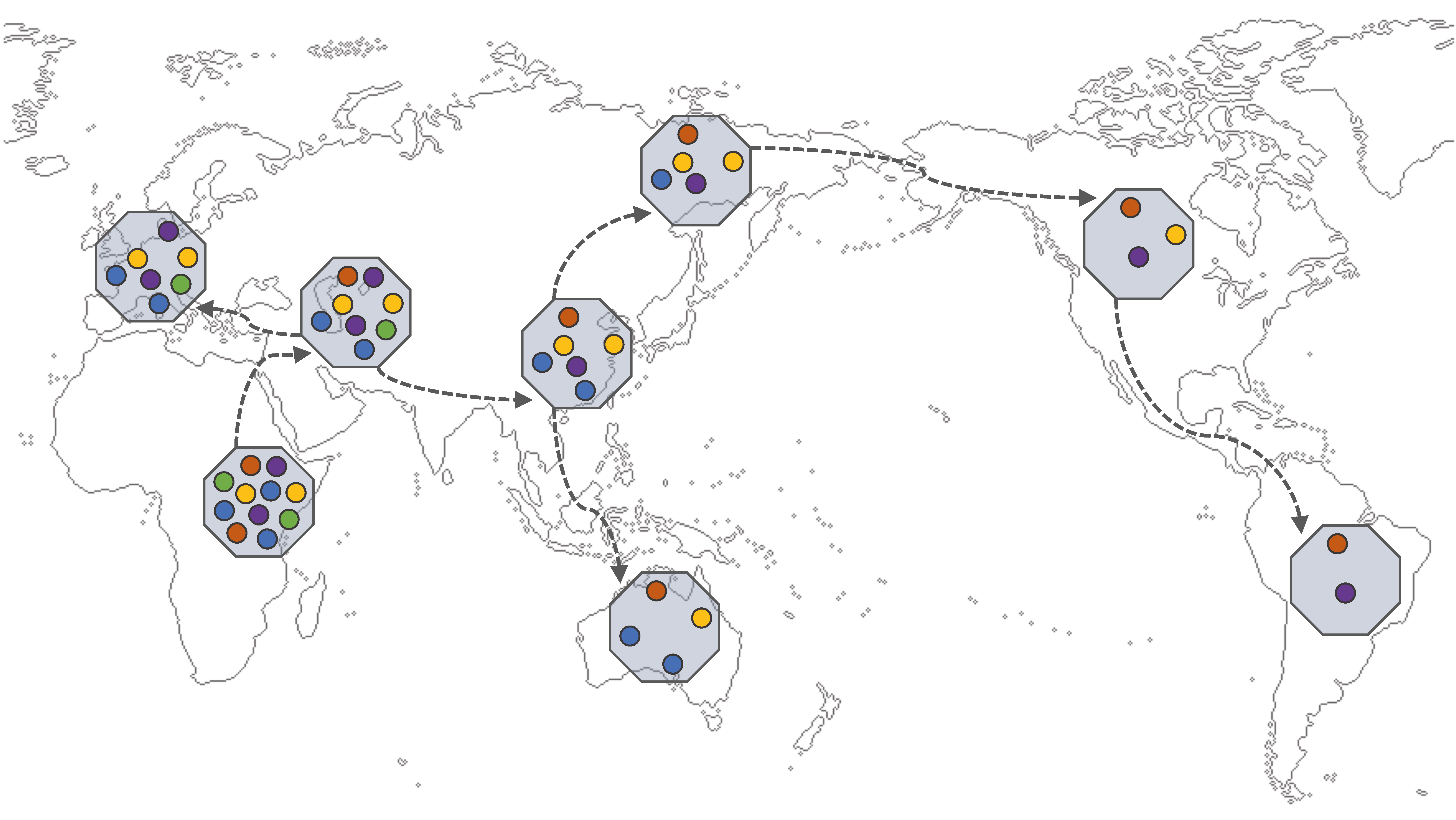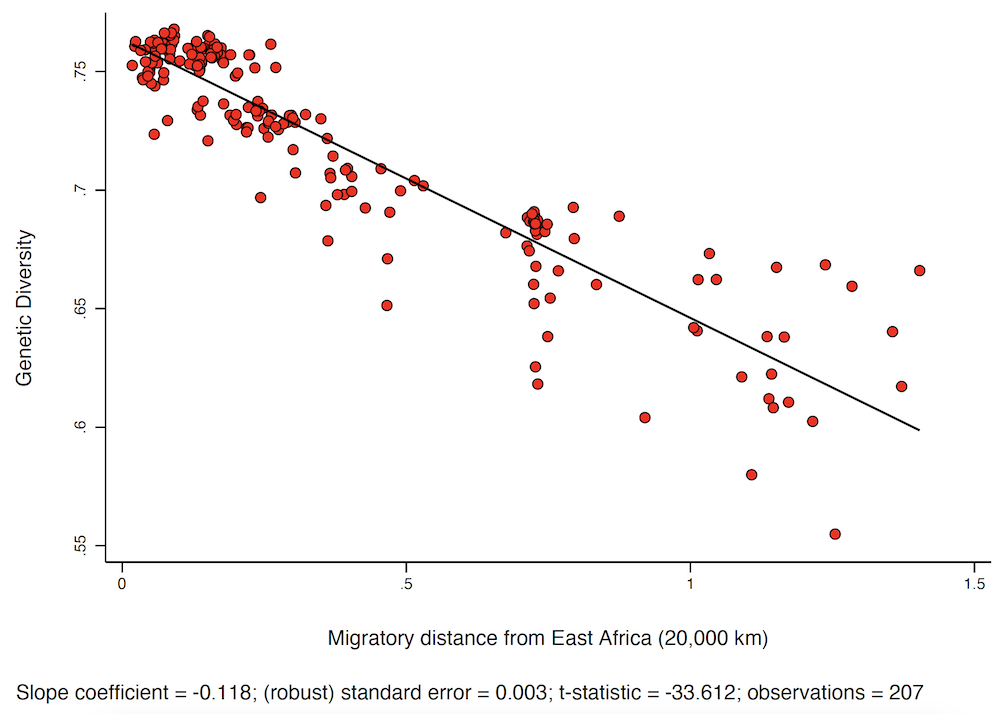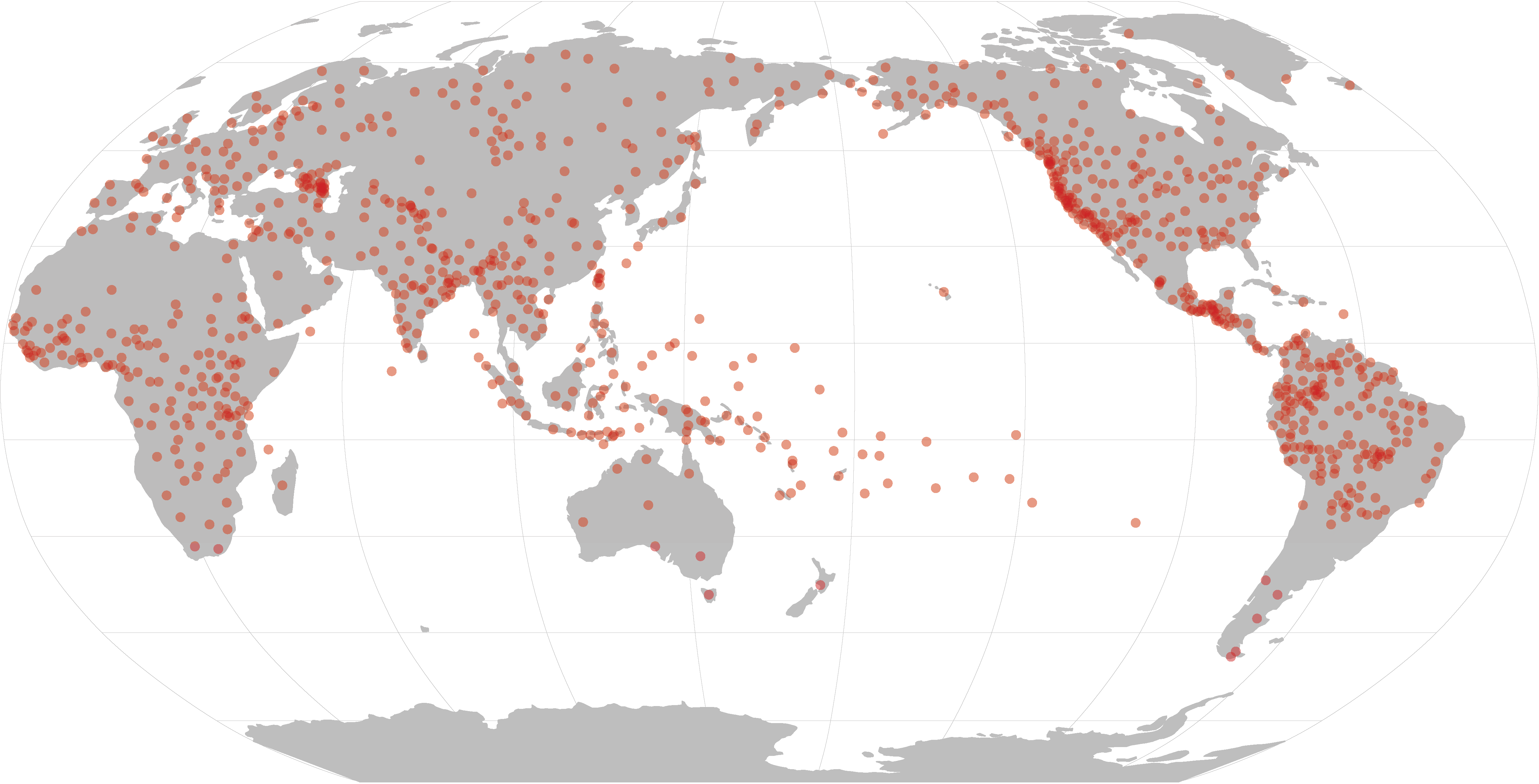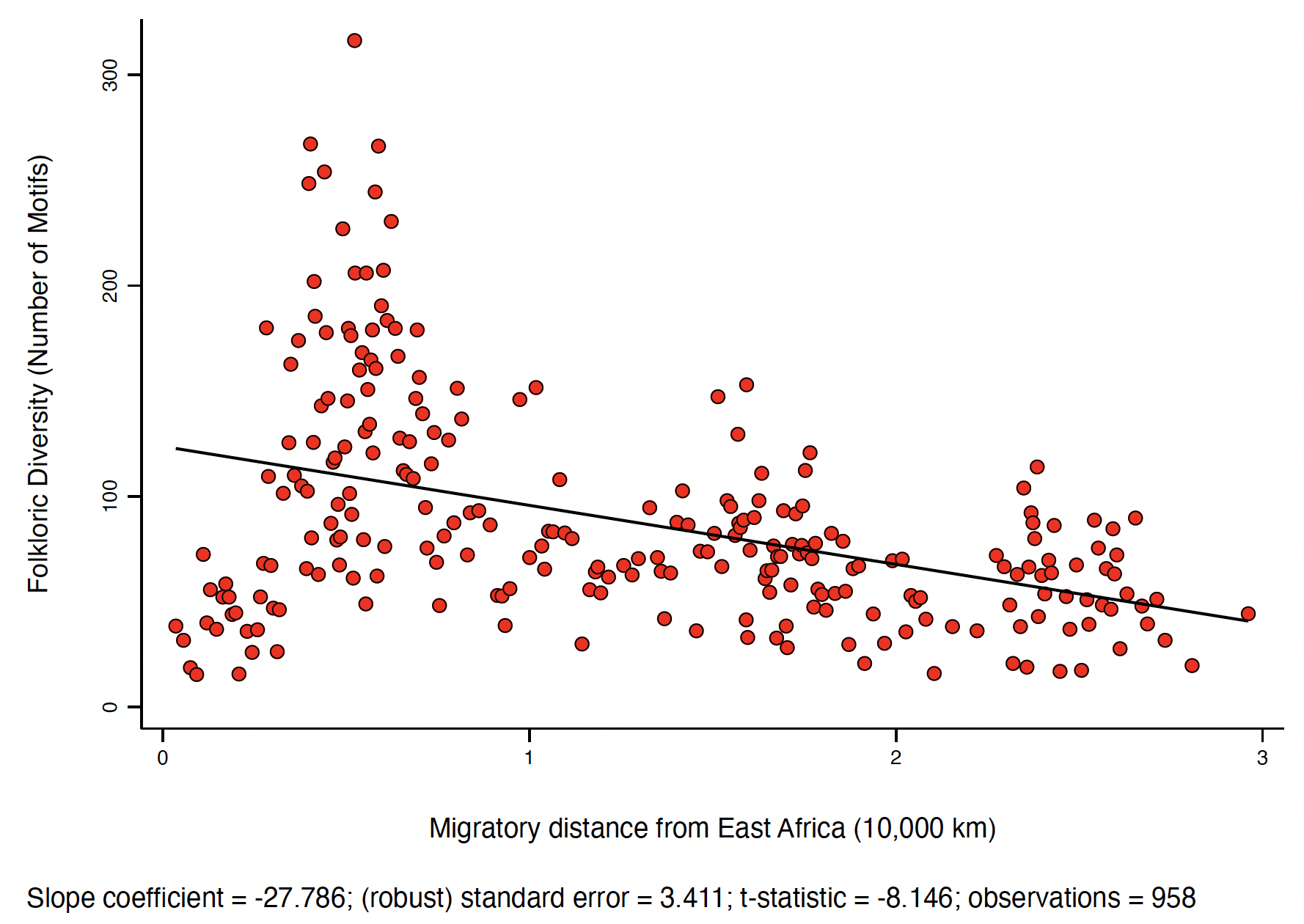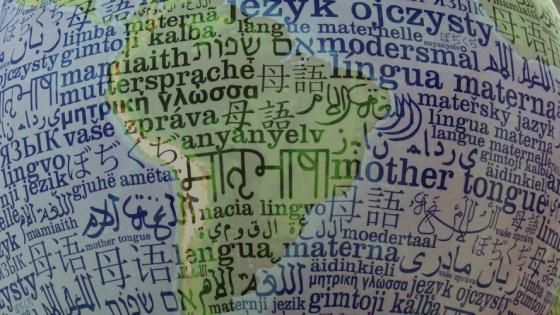Why does the degree of cultural diversity vary so markedly between different societies worldwide? What factors contribute to cultural diversity, and what are their consequences? Might delving into the underlying origins of cultural diversity provide insights for shaping policies aimed at fostering prosperity and reducing global inequality?
The prehistoric migration of Homo sapiens out of Africa stands as momentous and pivotal chapter in the history of humanity, forming the initial conditions for the evolution of human settlements and the course of economic development across the world. The dispersal of humanity across the planet unfolded in a stepwise manner, where in each step a subgroup of individuals left their ancestral settlement to establish a new colony farther away, carrying only a subset of the traits of their ancestral settlement.
Figure 1 The serial founder effect
Notes: This figure depicts the decline in the level of diversity along the migratory routes out of Africa
Source: Ashraf et al. (2021).
Due to the serial nature of this migratory pattern, the resulting serial founder effect was inherently associated with a reduction in the diversity of populations that settled at greater migratory distances from Africa. The further humans drifted from Africa, the lower the phenotypic, genetic, linguistic, and behavioral diversity in the societies that their descendants formed (e.g. Ramachandran et al. 2005, Manica et al. 2007, Betti et al. 2009, Atkinson 2011, Betti and Manica 2018, Arbatli et al. 2020). This in turn plausibly sets the stage for a differential evolution of cultural diversity across the world, resulting in a negative impact of migratory distance from the cradle of humanity in Africa on cultural diversity.
Figure 2 Declining diversity along the migratory routes out of Africa
Notes: This figure presents the reduction in population diversity among indigenous populations at greater migratory distances from Africa. It depicts the scatterplot of the association between the prehistoric migratory distance from East Africa and genetic diversity across 207 indigenous ethnic groups.
Source: Ashraf et al. (2021).
Societal diversity generates two opposing forces, with conflicting implications for development. On the one hand, diversity spurs cultural cross-pollination, enhances creativity, and inspires openness towards new ideas, fostering technological progress. On the other hand, diversity diminishes trust and provokes conflict, hindering social cohesiveness. For any stage of development, therefore, there is a level of societal diversity which balances these opposing forces and thus is most conducive for economic development (Ashraf and Galor 2013).
In view of the implications of societal diversity for economic prosperity, the potential impact of the out-of-Africa migration on cultural diversity could have significant consequences for the understanding of the mechanisms through which the migration out of Africa affected comparative economic development, providing tools for the mitigation of the uneven level of development across the globe. Yet, the depth of the imprint of this migratory process on cultural diversity has remained largely obscured.
Leveraging worldwide data on 958 oral traditions (i.e. ethnic groups or clusters of ethnic groups along linguistic lines; Figure 3) and 2,564 motifs from Berezkin’s Folklore and Mythology Catalogue (Berezkin 2015, Michalopoulos and Xue 2021), in a recent paper (Galor et al. 2023) we investigate whether the degree of folkloric diversity was shaped by the outcome of this migratory process. The catalogue documents folkloric motifs across the globe based on a consistent classification methodology, permitting the assessment of the imprint of the out-of-Africa migration on the diversity in the narratives of indigenous societies across the entire world. These motifs are the fundamental building blocks of oral traditions, capturing significant events, experiences, and images. Thus, plausibly, the number of motifs in each oral tradition, reflects the degree of cultural diversity within ethnic groups.
Figure 3 Locations of Berezkin's oral traditions
Notes: The figure depicts the locations of the 958 oral traditions (i.e., ethnic groups or clusters of ethnic groups along linguistic lines) surveyed in Berezkin's Folklore and Mythology Catalogue.
The findings suggests that indeed ethnic groups further from Africa along the prehistorical migratory routes have lower levels of cultural diversity, as captured by fewer motifs in their set of narratives. This result is consistent with the compression of genetic, phenotypic, and possibly phonemic traits along the out-of-Africa migration routes, setting the stage for the differential emergence and proliferation of cultural diversity across the world.
Figure 4 Number of motifs and migratory distance from Africa
Notes: The figure presents binned scatterplots and the raw association between the total number of motifs and migratory distance from Africa across oral traditions.
This intriguing evidence about the impact of the prehistoric migratory distance from Africa on cultural diversity across societies underscores the importance of the exploration of the long-lasting effects of the migration of humans out of Africa on cultural, institutional, and developmental outcomes across countries and ethnic groups, and more generally of the role of deep-rooted factors in comparative economic development. Moreover, establishing the impact of this migratory process on cultural diversity contributes to the understanding of the cultural channel in the impact of the out-of-Africa migration on trust, social cohesion, polarised political preferences, conflict, innovativeness, and comparative economic development (Ashraf et al. 2021).
The findings may be of utmost importance for informing policy design that can effectively nurture economic prosperity. Since the level of diversity that is conducive for affluence has increased in the past centuries due to the importance of cultural fluidity in a rapidly changing technological environment, understanding the roots of cultural diversity will be vital in the design of education policies that can foster diversity in societies that are relatively homogeneous and promote social cohesiveness in societies that are comparatively diverse.
References
Arbatlı, C E, Q H Ashraf, O Galor and M Klemp, (2020), “Diversity and Conflict”, Econometrica 88(2):727-797.
Ashraf, Q and O Galor (2013), “The ‘Out of Africa’ hypothesis, human genetic diversity, and comparative economic development”, American Economic Review 103(1):1-46.
Ashraf, Q, O Galor and M Klemp (2021), “The ancient origins of the wealth of nations", in The Handbook of Historical Economics, pp. 675-717.
Atkinson, Q D (2011), “Phonemic Diversity Supports a Serial Founder Effect Model of Language Expansion from Africa", Science 332(6027): 346-349.
Berezkin, Y (2015): “Folklore and Mythology Catalogue: Its Lay-out and Potential for Research", The Retrospective Methods Network Newsletter 10: 58-70.
Betti, L, F Balloux, W Amos, T Hanihara and A Manica (2009), “Distance from Africa, Not Climate, Explains Within-Population Phenotypic Diversity in Humans", Proceedings of the Royal Society B: Biological Sciences 276(1658): 809-814.
Betti, L and A Manica (2018), “Human Variation in the Shape of the Birth Canal is Significant and Geographically Structured", Proceedings of the Royal Society B: Biological Sciences 285(1889): 20181807.
Galor, O, M Klemp and D C Wainstock (2023), “The Impact of the Prehistoric Out of Africa Migration on Cultural Diversity”, NBER Working Paper No. 31274.
Manica, A, W Amos, F Balloux and T Hanihara (2007), “The Effect of Ancient Population Bottlenecks on Human Phenotypic Variation", Nature 448(7151): 346-348.
Michalopoulos, S and M M. Xue (2021), “Folklore", Quarterly Journal of Economics 136(4): 1993-2046.
Ramachandran S, O Deshpande, C C Roseman, N A Rosenberg, M W Feldman, L L Cavalli-Sforza LL (2005), “Support from the Relationship of Genetic and Geographic Distance in Human Populations for a Serial Founder Effect Originating in Africa", Proceedings of the National Academy of Sciences 102(44): 15942-15947.




